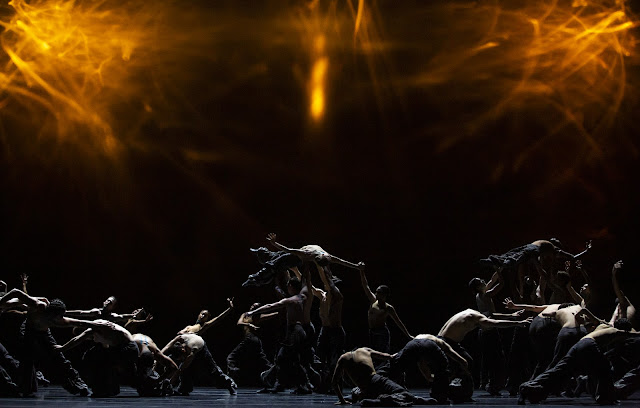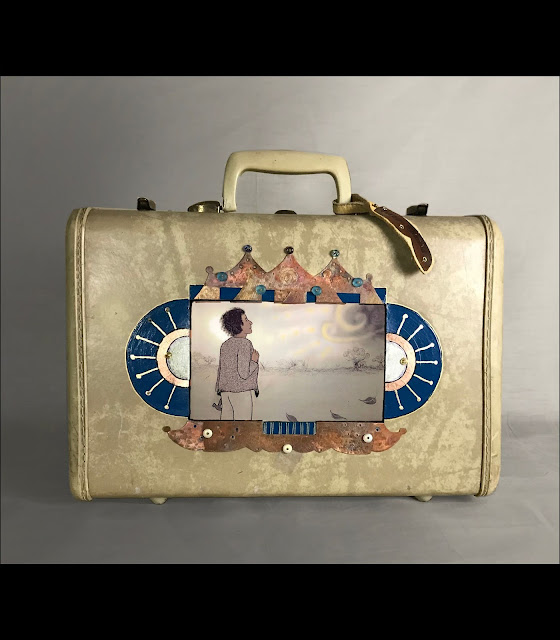Pacific Northwest Ballet company dancers in Crystal Pite's The Seasons' Canon. PNB presents The Seasons' Canon on a triple-bill with additional works by Jessica Lang and Twyla Tharp, onstage at Seattle Center's McCaw Hall April 12 - 21, 2024 (and streaming April 25 - 29.) For tickets and information, contact the PNB Box Office, 206.441.2424 or PNB.org. Photo (c) Angela Sterling, 2022.
Abstraction has always been a very important element, concept and ideal inflecting every movement throughout the history of art--and ballet has also been influenced by the ideals of abstraction. While many of ballet's best known dances are mainly narrative storytelling, ballet has always had elements of the abstract--scenes that because of the nature of the ballet as mute and gestural, often have that aspect that speaks toward abstraction. At it's most elemental, before narrative, without elaborate costumes and complex stage settings, silent--except for wordless music and the sounds of feet on the proscenium--ballet at its very heart owes it's basic substance to the fact that it is at its core made of bodies in motion.
PNB's The Seasons' Canon asks us to step away from the overwhelming power of concrete narrative and step into a world where metaphor is loose and the body, itself, merely moves through space with no clear story to tell. The choreography in this program reminds us, at times, of sea-life, classic Hollywood musicals, our own proms, industrialized machinery, and even takes us completely out of the realm of the metaphor into pure movement--the body itself in motion, creating a kind of poetry that does not depend on anything else, anyone else--except for the choreographer, the dancers and the viewer--all together and linked in one space--held together by these bodies and their organized movements.
Pacific Northwest Ballet's "Canon" brings to the stage three amazing investigations into the power of modern and contemporary ballet at its most primal and basic. Twyla Tharp, Jessica Lang and Crystal Pite--all living, all vibrant, all clear examples of women choreographers that have changed the face of the form. Each of these women has added their distinct outlook to the conversation, form and substance of ballet's history.

Pacific Northwest Ballet company dancers in Twyla Tharp's Sweet Fields(tm). PNB presents Sweet Fields on a triple-bill with additional works by Crystal Pite and Jessica Lang, onstage at Seattle Center's McCaw Hall April 12 - 21, 2024 (and streaming April 25 - 29.) For tickets and information, contact the PNB Box Office, 206.441.2424 or PNB.org. Photo (c) Angela Sterling, 2024.
Starting with Tharp, who interestingly was the first "Artist in Residency" at PNB starting in 2013; created the dance Waiting at the Station--right here in Seattle. Twyla Tharp was also the very first choreographer to create what is known as "Crossover Ballet," when In 1973, Tharp choreographed Deuce Coupe to the music of The
Beach Boys for the Joffrey Ballet. This type of ballet continues to be extremely important and influential to the current state of contemporary Ballet. Tharp is also known for her motion picture choreography--especially movies like "Hair" in 1979, "Amadeus" in 1984 and for working on projects with such musical luminaries as David Byrne, Billy Joel and Bob Dylan!
Sweet Fields, co-commissioned by UC Berkeley and the John F. Kennedy Center for Performing Arts--debuting in 1996 and including 18th and 19th century American hymns, reflects Tharp's own history and Quaker roots.
Interestingly, in Tharp's ballet, on Friday there is an odd distance between the music and the choreography--almost as though they are not quite communicating--as if they are out of sync, or ignoring each other--the music and movement appear to be almost separate organisms--like music in the background as life goes on in the foreground.
Here, Tharp's choreography is based on geometry and mathematics, (basically, all the things that this writer/artist is terrible at.) The costumes are light, summery and flowing, reflecting the breezy, quotational choreographic moves in this ballet, which make for a lively set of dances, but which seem somewhat dated in comparison to works by Pite and Lang.
Pacific Northwest Ballet principal dancer Dylan Wald in Jessica Lang's The Calling. PNB presents The Calling on a triple-bill with additional works by Crystal Pite and Twyla Tharp, onstage at Seattle Center's McCaw Hall April 12 - 21, 2024 (and streaming April 25 - 29.) For tickets and information, contact the PNB Box Office, 206.441.2424 or PNB.org. Photo (c) Angela Sterling, 2024.
Clocking in at 4 minutes, Lang's entry feels a bit like more of a sketch, somewhat unfinished and inchoate--but it does make for a much shorter, pithy night. The dance while seeeming to be simple, though is actually quite complex, and The Calling is perhaps the dance in "Canon" that is most like "performance art." It is a piece that takes dance and renders it immobile, and it is because of this that I would have liked to see Lang investigate this situation more thoroughly--perhaps extending the piece and taking it into the realms of durational performance. Much of The Calling has the visual effect of a dancer trying very hard not to fall down and I would have loved to see this delved into more thoroughly--it is simply put, too short. It needed more time in which to fully evolve into something amazing--rather than just a very neat idea!
Dance, in the piece, here is rendered simply into one body with limited mobility and the power of this piece comes from the sinews and musculature of a body and how that anatomy is contained in an oversized prison of a skirt that is contained and contains the dancer for the duration of the dance. This oversized costume extends and captures the dancers who take on this role, whose genders, races--though not body-types is not proscribed by Lang, and becomes the Director's choice. On opening night this was a male dancer, in this case Dylan Wald, who flexes, interacts and struggles with containing fabric that extends and continues his physical space, visual lines and anatomy.

Pacific Northwest Ballet company dancers in Crystal Pite's The Seasons' Canon. PNB presents The Seasons' Canon on a triple-bill with additional works by Jessica Lang and Twyla Tharp, onstage at Seattle Center's McCaw Hall April 12 - 21, 2024 (and streaming April 25 - 29.) For tickets and information, contact the PNB Box Office, 206.441.2424 or PNB.org. Photo (c) Angela Sterling, 2022.
Crystal Pite's The Seasons' Canon begins with Spring, which is presented to us as a kind of birth where bodies take turns responding to a metaphorical sun--swaying in a biomorphic rhythm. It is interesting that watching Pite's work, not just Canon, but much of her work, causes the mind to want to create mini-narratives--of crabs on the coast of Madagascar--or some other warm, faraway, magical place. Or we are made to think of hardworking Victorian workers in an industrial, steel-mill, or maybe even penguins on the south pole! Or is this all a response to and evolution from the collected works of Busby Berkeley--like the visual language of Matthew Barney?
In the Autumn section of the larger piece--are we meant to think of the classic Fritz Lang bit of cinematic brilliance--"Metropolis?" Or are these figures, in fact, fighters engaged in retaliation against each other? Are they boxers from a George Bellow's painting? Are they lovers? Enemies?
Finally, though are we really meant to see these various scenes quite so literally? Or is Pite having more fun with this? Like Tharp's mathematics and Lang's gestures--is she actually just playing with the forms and movements of the body? Is there a clue in how she uses light and color throughout? Color, for Pite is very important. Her bodies are presented to us in reds, greens and grays, adding to the sense that yes, her work can be seen as including quotation quite liberally, perhaps this is gestural, allusive--perhaps it is not ultimately meant to be merely narrative, but abstract and artistic? Perhaps, Pite is working in a sense that is similar to the ways in which we respond to light, color or wordless music--we do not expect any of these to tell us a story. Instrumental music speaks in a different language, one without narrativity. Light and color just are!
In PNB's production--each of the three choreographers this night appears to be investigating their own sense of abstraction to hit us at a deeper, more holistic, and intimate level--beyond stories, beyond words, beyond--even irony. At each of these artists' best, their work transcends and becomes much larger than mere allusion. Each exists at its best moments in a transitory, liminal space where narrative can't get to it and do what it tends to do--to make a mockery of everything--they create spaces where we are presented glimpses of ballet at its most basic--as just bodies in motion.
And sometimes, that is exactly enough!
Pacific Northwest Ballet company dancers in Crystal Pite's The Seasons' Canon. PNB presents The Seasons' Canon on a triple-bill with additional works by Jessica Lang and Twyla Tharp, onstage at Seattle Center's McCaw Hall April 12 - 21, 2024 (and streaming April 25 - 29.) For tickets and information, contact the PNB Box Office, 206.441.2424 or PNB.org. Photo (c) Angela Sterling, 2022.








Comments
Post a Comment